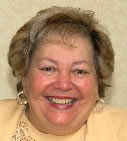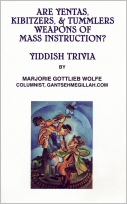  
|
  
|
*In Yiddish, "Gelt iz kaylekhdik--amol iz es do, amol iz es dort"

Would you believe that a penny actually costs 1.4 cents to produce? "Es iz nit geshtoygn un nit gefloygn" - It just doesn't make sense.
Pennies are becoming the new decorative stuff to put inside the Blue Box, the big " gloz" (glass) or "plastik" (plastic) container.
Jim Kolbe, R - Arizona, plans to reintroduce legislation to eliminate the penny. He said, " Most people still think the penny has no purpose and we shou ld get rid of it." (He suggests that we round up cash transactions to the nearest 5 cents.) Rounding to the nickel would effectively raise prices. This change would hurt those who can afford it the least, the "orem" (poor) and the "alt" (elderly).
The Mint gets letters with pennies taped on notebook "papir." These letters are from citizens who found the pennies on the street and mailed them back to the Treasury to help pay down the debt.
At my local kosher deli, they have a "Give a Penny, Take a Penny" dish. It's a place where fellow penny haters can leave their unwanted coins or "ekstre" (extra) pennies. It's FREE MONEY--a Syosset (Long Island) penny repository. The counterhelp hope that the customers don't become " tsemisht" (confused) and use it as a "Tip Jar."
And there's even a Simpsons' episode titled, "Who Shot Mr. Burns?" where the lab tech says, "If you've ever handled a penny, the government has your DNA on file. Why do you think they keep them in circulation?"
Here's a question...and be honest with your answer: "If you dropped a penny on " di erd" (the ground), would you just leave it lying there? And, when was the last time you saw a vending machine which accepted pennies?
What do these candies have in common: Jaw breakers, long paper strips with candy dots, rock candy on a stick, and bubble-gum cigars? They all ONCE cost a penny! (Penny candies came into being sometime in the mid 1800s. There were over 380 candy factories in America alone producing what we call penny candy.)
According to Martin Jacobs, someone who is thrifty is "shporevid." Thrifty people ate at the automatic, where hot and cold foods were placed in slots behind glass. Horn & Hardart opened the first New York automat in 1912; a nickel bought a cup of coffee. In 1950, the price of the automat's coffee went to a dime. (The coffee could NOT be raised to 6 or 8 cents because the tiny doors only accepted nickels.) In the darkest days of the Depression, hungry New Yorkers made a drink by mixing the FREE water with the ketchup and Worcestershire sauce located on the lazy susans at each table.
In 1973, Sam Levenson ("In One Era & Out the Other") wrote about frugality: "The American way was to frugal your way up the ladder of success." He collected pennies. He learned from his Mama that " A penny is a lot of money if you haven't got a cent...A penny saved saved a person from the humiliation of dependence upon others."
The most humorous part of Levenson's " bukh" was the story of how he mastered the technique of converting copper pennies into nickels. He wrote, "You place a penny on the tracks and allowed it to be run over by a trolley. This spread the penny to the size of a nickel, which could then be inserted into a turnstile. Some kids sold these penny nickels for two cents. I didn't. That would have been dishonest."
And Levenson divulged a conversation with his father:
Levenson: "Give me a nickel or I'll run away from home!"
Father: "I won't give you a penny, and you can take your brother Albert."
__________
Marjorie Gottlieb Wolfe would like to give readers her two cents, but she can't scrounge up another penny.
| A | B | C | D | E | F | G | H | I | J | K | L | M |
| N | O | P | Q | R | S | T | U | V | W | Y | Z |


| Yiddish
Stuff Jewish Humor Schmooze News More Majorie Wolfe |
Principle Jewish Stories All Things Jewish Jewish Communities of the World |